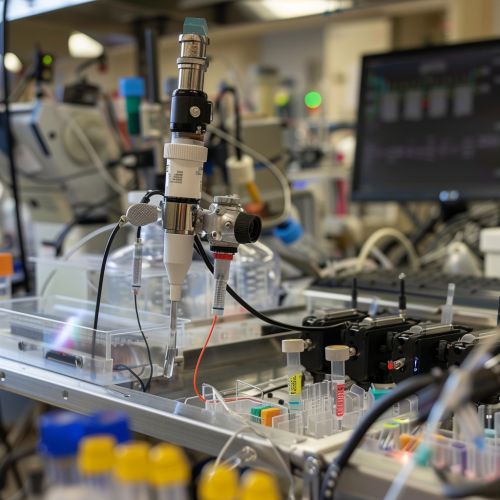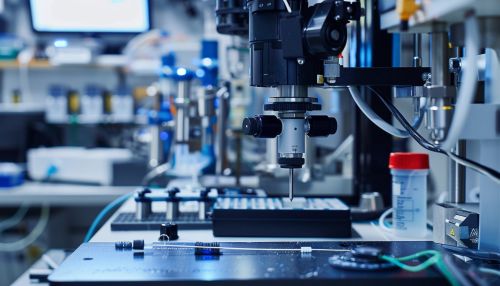Probes
Introduction
A probe is a device or instrument that is used to explore, investigate, or measure something. Probes are used in a variety of fields, including physics, chemistry, biology, medicine, space exploration, and computer science. They are designed to gather data about their environment or subject, often in conditions that are difficult or impossible for humans to survive or access.


Types of Probes
There are many different types of probes, each designed for a specific purpose or field of study. Some of the most common types include:
Physical Probes
Physical probes are used in physics to measure properties such as temperature, pressure, and humidity. These probes often consist of a sensor that is placed in the environment to be measured, and a device that records the data. Examples of physical probes include thermometers, barometers, and hygrometers.
Chemical Probes
Chemical probes are used in chemistry to measure properties such as pH, concentration of specific ions, or the presence of certain molecules. These probes often consist of a sensor that reacts with the substance to be measured, and a device that records the data. Examples of chemical probes include pH meters, spectrophotometers, and gas chromatographs.
Biological Probes
Biological probes are used in biology to study living organisms. These probes often consist of a sensor that interacts with the organism or tissue to be studied, and a device that records the data. Examples of biological probes include microscopes, endoscopes, and ultrasound devices.
Medical Probes
Medical probes are used in medicine to diagnose and treat diseases. These probes often consist of a sensor that interacts with the body, and a device that records the data. Examples of medical probes include stethoscopes, echocardiograms, and MRI machines.
Space Probes
Space probes are used in space exploration to gather data about the universe. These probes often consist of a spacecraft equipped with a variety of sensors and instruments, and a ground station that receives and records the data. Examples of space probes include the Voyager spacecraft, the Mars rovers, and the Hubble Space Telescope.
Computer Probes
Computer probes are used in computer science to monitor and debug software and hardware. These probes often consist of a software tool or hardware device that interacts with the computer system, and a device that records the data. Examples of computer probes include debuggers, network analyzers, and performance monitors.
Design and Operation
The design and operation of a probe depend on its intended use. However, all probes share some common features. They all have a sensor or instrument that interacts with the environment or subject, a device that records the data, and a means of transmitting the data to a location where it can be analyzed.
The sensor or instrument is the part of the probe that interacts with the environment or subject. It is designed to respond to specific properties or conditions, such as temperature, pressure, pH, light, sound, or magnetic fields. The sensor or instrument generates a signal that is proportional to the property or condition it is measuring.
The recording device is the part of the probe that stores the data generated by the sensor or instrument. It may be a simple data logger that records the data for later analysis, or it may be a sophisticated computer system that processes the data in real time.
The transmission system is the part of the probe that sends the data to a location where it can be analyzed. It may be a simple wire that connects the probe to a recording device, or it may be a complex radio system that transmits the data to a ground station or satellite.
Applications
Probes have a wide range of applications, from basic scientific research to advanced technology development.
In physics, probes are used to measure properties such as temperature, pressure, and humidity in a variety of environments, from the laboratory to the natural world. In chemistry, probes are used to measure properties such as pH, concentration of specific ions, or the presence of certain molecules in a variety of samples, from pure substances to complex mixtures. In biology, probes are used to study living organisms, from single cells to entire ecosystems.
In medicine, probes are used to diagnose and treat diseases. They are used to image the body, measure physiological parameters, and deliver treatments. In space exploration, probes are used to gather data about the universe, from the solar system to distant galaxies. In computer science, probes are used to monitor and debug software and hardware, from individual programs to complex networks.
Future Developments
The field of probes is constantly evolving, with new types of probes being developed and existing ones being improved. Future developments in probes are likely to be driven by advances in technology, such as miniaturization, wireless communication, and artificial intelligence.
Miniaturization is making probes smaller and more portable, allowing them to be used in more places and in more ways. Wireless communication is allowing probes to transmit data over greater distances and in more challenging environments. Artificial intelligence is allowing probes to process and analyze data in more sophisticated ways, making them more powerful and versatile.
